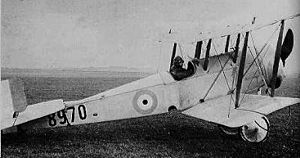| Bristol Scout | |
|---|---|
 RNAS Bristol Scout D of third production batch | |
| General information | |
| Type | single-seat scout/fighter |
| Manufacturer | British and Colonial Aeroplane Company |
| Designer | |
| Primary users | Royal Flying Corps |
| Number built | 374[1] |
| History | |
| Manufactured | 1914–1916 |
| First flight | 23 February 1914 |
The Bristol Scout was a single-seat rotary-engined biplane originally designed as a racing aircraft. Like similar fast, light aircraft of the period it was used by the RNAS and the RFC as a "scout", or fast reconnaissance type. It was one of the first single-seaters to be used as a fighter aircraft, although it was not possible to fit it with an effective forward-firing armament until the first British-designed gun synchronizers became available later in 1916, by which time the Scout was obsolescent. Single-seat fighters continued to be called "scouts" in British usage into the early 1920s.[1]